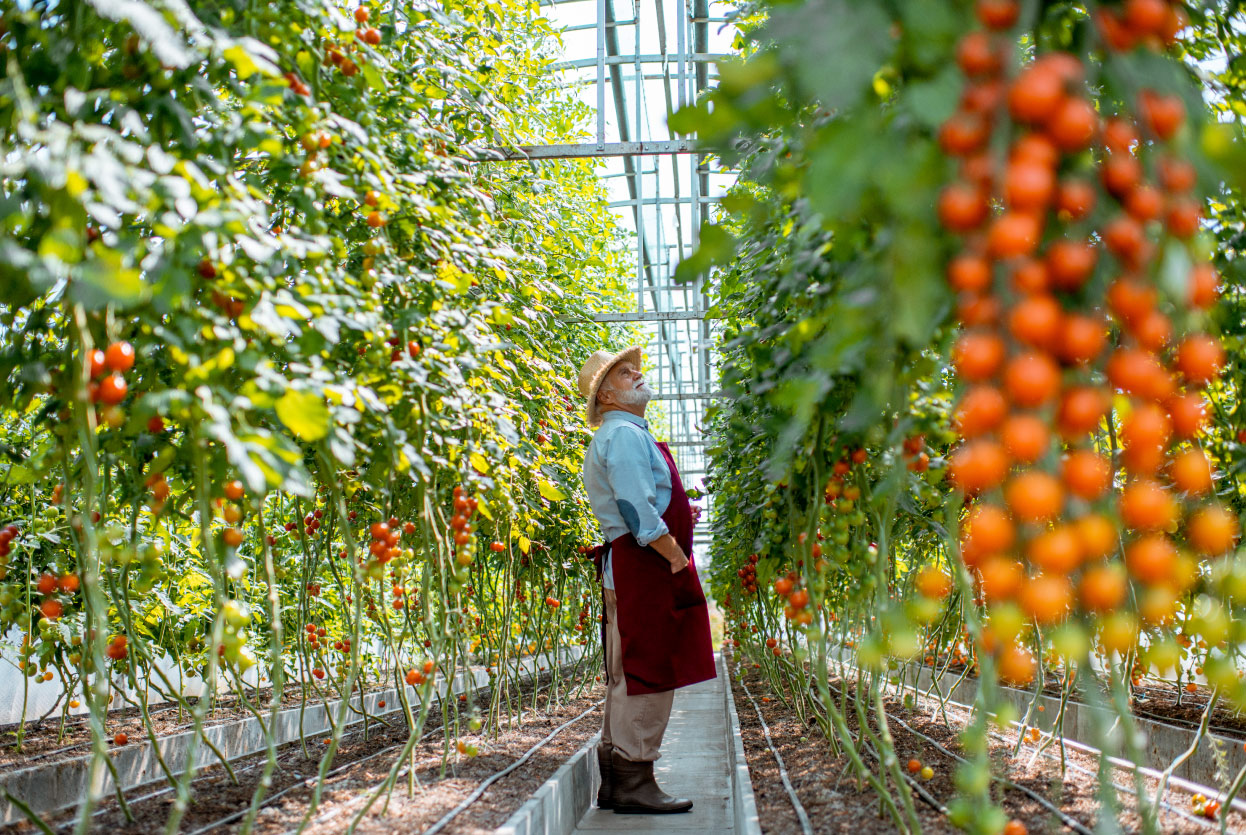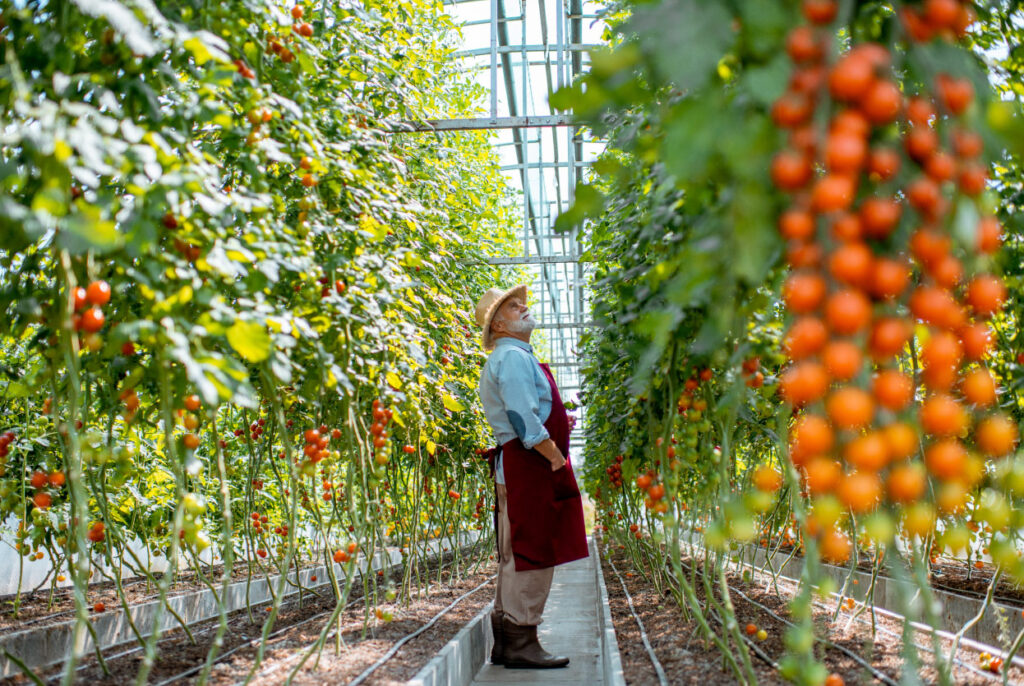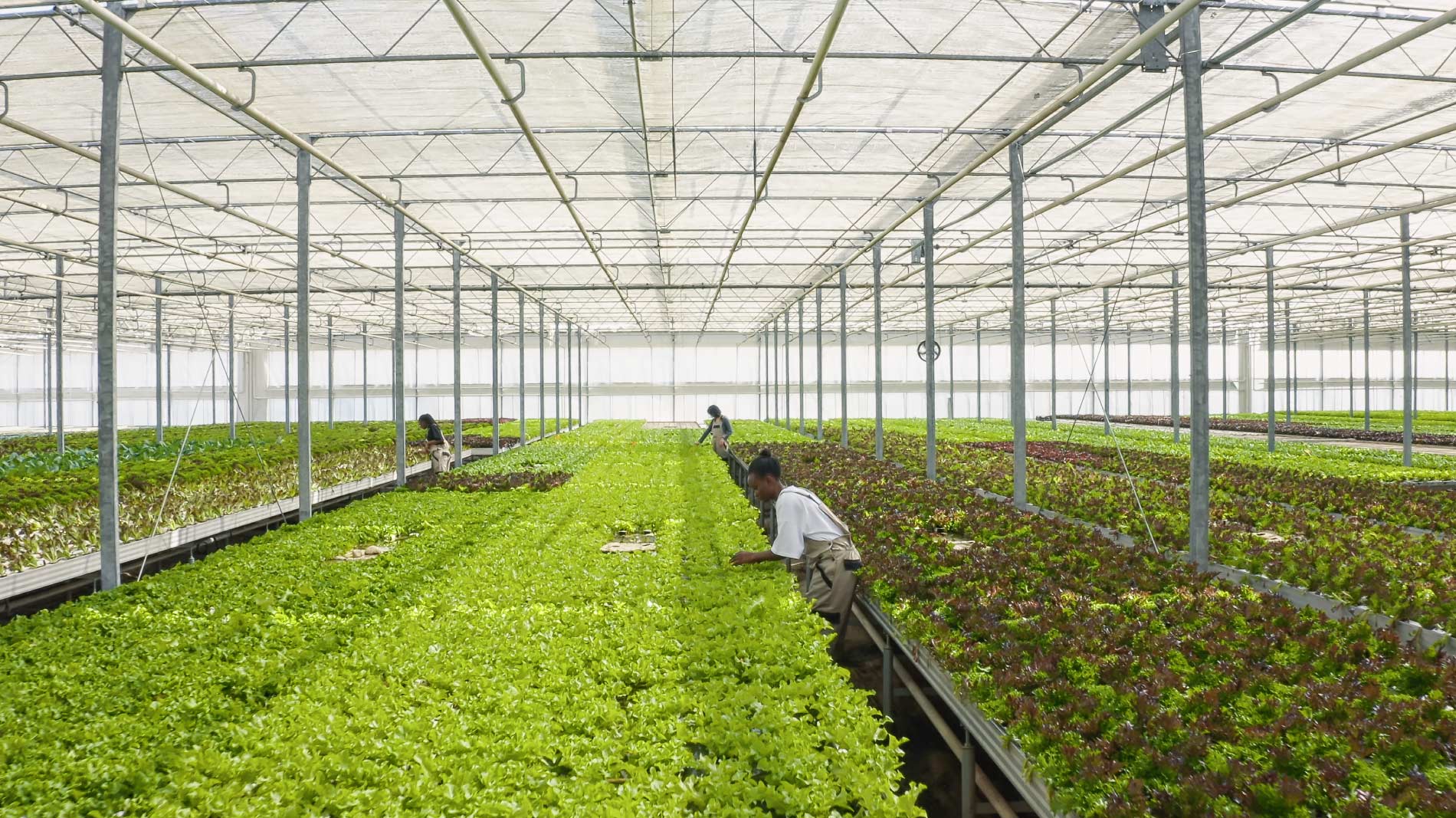
Growing the Red Gold: A Guide to Greenhouse Tomato Production in the U.S.

Plump, vibrant red tomatoes are a quintessential ingredient in kitchens across America. But the journey many of these tomatoes take to our tables starts not in an outdoor field, but in the carefully controlled environment of a greenhouse.
Tomatoes reign as the leading greenhouse-grown crop in the United States, accounting for over $600 million in annual production value. As consumer demand surges for fresh, flavorful tomatoes year-round, greenhouse cultivation has become an increasingly vital sector of the country’s agriculture industry.
The advantages of growing tomatoes under the protected cover of greenhouse structures are plentiful. Growers can precisely regulate temperature, humidity, light, irrigation, and fertilizer levels to create the perfect climate for tomato plants to thrive. This allows for higher yields per square foot compared to field production. Greenhouses also extend regional growing seasons and open up new geographical frontiers for tomato cultivation.
While greenhouses require higher start-up costs, the consistent yields, quality control, and lower water/pesticide usage make them an economically and environmentally sustainable choice for commercial tomato operations. As renewable energy like solar power becomes more integrated, greenhouse farming’s eco-friendly credentials continue strengthening.
The United States has several emerging greenhouse tomato production hubs emerging across the nation:
- Central California’s temperate valleys
- The desert southwest region around Yuma, Arizona
- Southern Florida and Mexico border regions in Texas
- The greenhouse hotbeds of Canada seeping into northern states
In these areas, greenhouse tomato operations both large and small are rapidly proliferating to meet insatiable consumer cravings. Leveraging the latest cultivation technology and techniques, they collectively supply a bumper crop of delicious tomatoes to American markets 365 days a year.
With robust growth projections, greenhouse tomato farming is cementing itself as a mighty force shaping the future of U.S. agriculture. Growers embracing this intensive, climate-smart approach unlock a cornucopia of fresh tomato bounty previously unimaginable.
Choosing the Right Variety for REGASA Greenhouses
With hundreds of tomato cultivars to choose from, selecting the ideal varieties for greenhouse production is one of the first critical decisions growers must make. The tomato variety sets the stage for factors like plant vigor, fruit quality, and overall yield potential.
Some of the most popular and commercially successful greenhouse tomato varieties include:
Cherry/Grape Tomatoes – Small, oblong or round fruit with an intense, sweet flavor. Varieties like Cherry Buzz, Piccolo, and Mavour are extremely prolific.
Beefsteak Tomatoes – These large, ribbed, juicy slicing tomatoes are greenhouse stars. Big Beef, Biltmore, and Bravence are common choices.
Cluster Tomatoes – Bred to produce trusses of 4-12 fruits like grapes. Excellent for single-harvest trusses. Popular clusters include Camarro, Campari, and Komeett.
Roma/Plum Tomatoes – Oval, meaty, low-moisture fruit perfect for sauces and pastes. Picus, Rio Grande, and Hunter are flavorful romas.
When evaluating varieties, key traits greenhouse growers prioritize are:
Vigor and High Yield – Varieties able to produce heavy, consistent yields under protected conditions.
Fruit Quality – Exceptional flavor, firmness, color and shelf-life for market. Disease Resistance – Tolerance against common fungal, viral and bacterial tomato pathogens.
Many of the top greenhouse varieties are hybrid cultivars, bred for increased vigor, uniformity and specific trait combinations. However, some growers choose to produce open-pollinated heirloom varieties to tap into the premium pricing and demand for unique, branded tomato varieties.
No matter the variety selected, greenhouse growers must match tomato cultivars to their specific systems, markets and customer preferences. Analyzing characteristics like plant habit, heat-setting ability, shelf-life and flavor profile is essential to determining the ideal tomato variety mix.
Creating the Ideal Greenhouse Environment
While greenhouses provide protection from extreme external conditions, creating the ideal environment inside is critical for maximizing tomato plant growth and fruit production. Temperature, light levels, humidity, irrigation and growing media must all be optimized.
Temperature
Tomato plants thrive in warm environments between 70-85°F during the day and 62-70°F at night. At cooler temps, pollen becomes inviable. Excess heat over 95°F can cause flower and fruit abortion.
Most greenhouses use natural gas or hot water heating systems combined with circulation fans to maintain ideal temperatures year-round. Sophisticated climate control computers make adjustments based on outdoor conditions.
Light
Tomatoes need intense, consistent light levels around 6,000-8,000 foot-candles for optimal photosynthesis. Traditional greenhouses rely on sunlight exposure and supplemental lighting like high-pressure sodium lamps. Newer LED systems are more energy-efficient.
Humidity
The perfect humidity range is 60-70% relative humidity. Too high creates conditions for fungal diseases; too low causes issues with pollen fertility. Humidity is regulated through venting, evaporative coolers, and horizontal air flow fans.
Irrigation
Consistent water management is key in greenhouses. Most tomato crops utilize drip irrigation tubing systems that slowly deliver water right to the root zone. This maximizes efficiency and minimizes disease vectors.
Computerized fertigation systems precisely inject nutrients into the water, providing plants with the ideal nutrient solution they require at different growth stages.
Growing Media
While some greenhouse tomatoes are grown in soil-based mixes, the majority leverage hydroponic systems with inert growing media like:
- Rockwool slabs – Spun rock fibers provide aeration and moisture retention
- Coconut coir – Made from renewable coconut husks
- Perlite or vermiculite – Heat-expanded mineral additives
- Nutrient film technique (NFT) – Plants grown with roots suspended in circulating liquid nutrient solution
These soilless media, combined with efficient nutrient delivery, create the optimal root environment to drive faster growth and higher yields.
By dialing in all aspects of the greenhouse atmosphere, growers can essentially create a tailored “Goldilocks” microclimate where every condition is just right for tomato crops to flourish all year long.
Planting and Crop Management
Once the ideal greenhouse environment is established, properly executing planting and crop management tactics is crucial for a successful, high-yielding tomato crop.
Transplanting and Spacing
Most greenhouse tomatoes are transplanted from seed trays or plugs into the final growing system as seedlings. This head start allows more controlled germination and robust root development.
Spacing between plants and rows is an important consideration. Determinate bush varieties can be planted 12-18 inches apart in rows spaced 3-4 feet. Indeterminate vining types need 18-36 inches between plants with 5-6 foot row spacing to allow for trellising.
Staking, trellising or caging plants provides support and improves air flow, light exposure and spray coverage. Common systems include string weaving and hook hangers for vining types.
Pruning and De-Leafing
To maximize yields and fruit quality, strategic pruning and de-leafing is required through the season. Suckers (side shoots) are trimmed from the main stem on indeterminate varieties to divert energy into fruiting trusses.
Judicious de-leafing, where some leaves are stripped from the lower canopy, further improves airflow and light penetration while nudging plants into reproductive mode.
Fertilization Program
Tomatoes are heavy “feeders” requiring optimum nutrition levels provided through a regimented fertilization program. During early vegetative growth, a nitrogen-rich fertilizer is applied. This shifts to higher phosphorus and potassium formulations to promote flowering and fruit development.
The fertigation system allows a grower to easily vary the nutrient solution makeup based on specific crop needs through each growth stage.
Irrigation Scheduling
While tomatoes have relatively high water needs, overwatering can trigger diseases and nutrient deficiencies. Careful scheduling based on factors like plant size, humidity levels and water retention rates in the growing medium is required.
Many operations utilize tensiometers or moisture sensors integrated with the irrigation computer to automatically deliver precise water volumes.
Integrated Pest Management
Within an enclosed greenhouse, implementing integrated pest management (IPM) is essential for controlling insects, mites, fungi, viruses and other threats that can devastate the crop.
Biological controls like predatory wasps, beneficial nematodes and bacterial/fungal formulations are released to combat pests. Sticky traps help monitor population levels. Optimal climate control minimizes conducive conditions for diseases.
Targeted biopesticide sprays are utilized only when absolutely needed, as a last resort. The goal is to create a balanced greenhouse ecosystem with minimal intervention.
With diligent planting, pruning, nutrition, irrigation and IPM practices, greenhouse tomato crops can achieve their full genetic yield potential while maintaining premium fruit quality from start to finish.
Harvesting and Post-Harvest Handling
The journey from vine to table culminates with proper harvesting and handling of greenhouse tomato crops. Timing, technique and post-harvest processes are key for preserving maximum freshness and shelf life.
Maturity and Harvest Timing
There are several maturity indicators that signal prime harvest time. For cherry/grape tomatoes, size, deep color, and ease of detachment indicate ripeness. Slicing varieties should separate easily from the stem with just a gentle twist when mature.
Other indicators include the development of proper colors like pinkish/red tones from the blossom end, as well as that unmistakable fresh tomato aroma. Precise harvest timing is essential for capturing peak flavor and firmness.
Harvesting Methods
Most greenhouse operations still rely on manual harvesting using skilled labor crews. Workers deftly identify mature tomatoes and gently twist or clip them from the vine, being careful not to damage stems or fruit.
For high density crops like cherry tomatoes, workers often harvest entire trusses by snapping them off the plant. This allows more efficient bulk harvesting and grading.
Some larger operations utilize mechanical harvesters – essentially tractor vehicles with rotating spinners that shake and dislodge mature fruit from the vines. While efficient, mechanical harvesting increases fruit damage and is more suitable for processing tomatoes.
Grading and Packing
After harvesting, tomatoes are inspected and graded based on USDA standards that assess size, shape, color and defects. Only undamaged, premium fruit is packed for the fresh market.
Tomatoes are usually cleaned with food-grade chlorine solutions to remove dirt and pathogens. They are then sized, sorted and carefully packed into plastic clamshell containers, cardboard trays or bulk cartons.
Packing rooms are kept cool at around 55°F to temporarily remove field heat and slow respiration rates. Humidifiers may also be used to prevent moisture loss and shriveling.
Cold Chain Management
Maintaining the cold chain from pack house to distribution is vital. Tomatoes are highly perishable and lose quality, nutrition and shelf life when not properly refrigerated.
Most greenhouse tomatoes are stored and transported at the ideal 55-58°F range and 85-90% humidity. Refrigeration truck/rail transport is utilized for longer distance distribution before final storage at retail facilities.
Through every stage – from planting and harvesting to packing and distribution – meticulous care and cutting-edge practices converge to consistently deliver the highest quality, best tasting greenhouse tomatoes to consumers nationwide.
And when you’re ready to capitalize on this booming opportunity by constructing your own advanced greenhouse operation, look no further than REGASA. Our premium greenhouse designs, backed by decades of experience and industry-leading technology, provide the ideal controlled environments for growing profitable tomato crops year-round. Contact us today to discuss your greenhouse project vision



No Comments